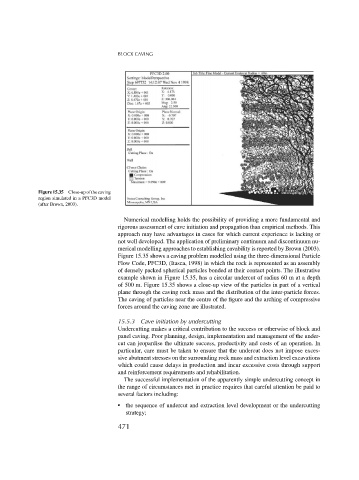Page 489 - Rock Mechanics For Underground Mining
P. 489
BLOCK CAVING
Figure 15.35 Close-up of the caving
region simulated in a PFC3D model
(after Brown, 2003).
Numerical modelling holds the possibility of providing a more fundamental and
rigorous assessment of cave initiation and propagation than empirical methods. This
approach may have advantages in cases for which current experience is lacking or
not well developed. The application of preliminary continuum and discontinuum nu-
merical modelling approaches to establishing cavability is reported by Brown (2003).
Figure 15.35 shows a caving problem modelled using the three-dimensional Particle
Flow Code, PFC3D, (Itasca, 1998) in which the rock is represented as an assembly
of densely packed spherical particles bonded at their contact points. The illustrative
example shown in Figure 15.35, has a circular undercut of radius 60 m at a depth
of 500 m. Figure 15.35 shows a close-up view of the particles in part of a vertical
plane through the caving rock mass and the distribution of the inter-particle forces.
The caving of particles near the centre of the figure and the arching of compressive
forces around the caving zone are illustrated.
15.5.3 Cave initiation by undercutting
Undercutting makes a critical contribution to the success or otherwise of block and
panel caving. Poor planning, design, implementation and management of the under-
cut can jeopardise the ultimate success, productivity and costs of an operation. In
particular, care must be taken to ensure that the undercut does not impose exces-
sive abutment stresses on the surrounding rock mass and extraction level excavations
which could cause delays in production and incur excessive costs through support
and reinforcement requirements and rehabilitation.
The successful implementation of the apparently simple undercutting concept in
the range of circumstances met in practice requires that careful attention be paid to
several factors including:
the sequence of undercut and extraction level development or the undercutting
strategy;
471

